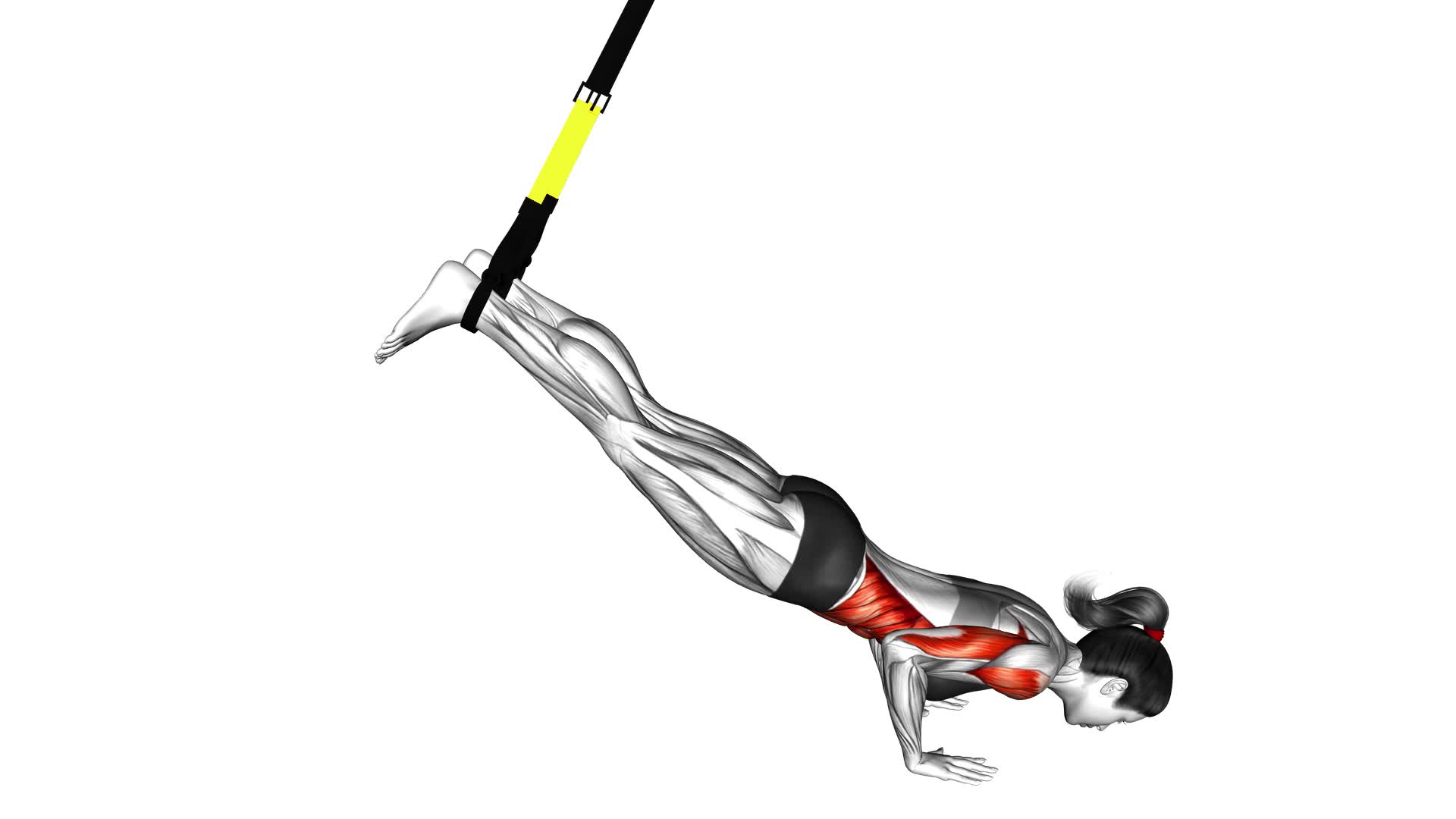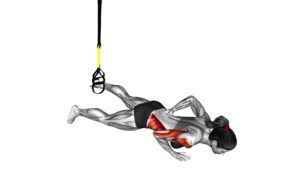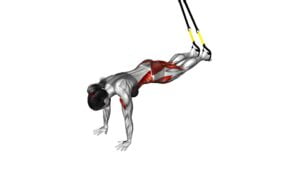Suspender Incline Push-up (female) – Video Exercise Guide & Tips

Get ready to level up your push-up game with the Suspender Incline Push-Up! This exercise is perfect for females looking to strengthen their upper body.
Watch This Exercise Video
In this video exercise guide, we'll show you the proper form, modifications for all fitness levels, and common mistakes to avoid.
Plus, we'll give you tips on how to incorporate this challenging move into your workout routine.
Let's get started and take your push-ups to new heights!
Key Takeaways
- The Suspender Incline Push-up targets multiple major muscle groups in the upper body.
- Proper form and technique are essential to prevent injury and maximize results.
- Beginners can start with modifications such as higher straps or a lower incline angle.
- Advanced variations include lifting one leg off the ground or using an elevated surface for feet.
Benefits of the Suspender Incline Push-up
What are the benefits of the Suspender Incline Push-up for you?
The Suspender Incline Push-up is a highly effective exercise that targets several major muscle groups in your upper body. During this exercise, your chest, shoulders, triceps, and core muscles are all engaged and strengthened. By incorporating the suspender incline push-up into your workout routine, you can develop a stronger and more toned upper body.
One of the great things about the suspender incline push-up is that it can be easily modified to increase the difficulty level as you progress. You can adjust the height of the incline to challenge yourself further. By placing the suspension straps higher, you'll increase the angle, making the exercise more challenging. This modification will require your muscles to work harder, leading to greater strength gains and muscle development.
In conclusion, the benefits of the Suspender Incline Push-up are numerous. Not only does it target and strengthen multiple muscle groups in your upper body, but it also offers the flexibility to increase the difficulty level as you become stronger.
Now let's move on to discussing the proper form for the suspender incline push-up.
Proper Form for the Suspender Incline Push-Up
To perform the Suspender Incline Push-Up with proper form, focus on maintaining a strong and stable plank position throughout the exercise. This will ensure that you engage the correct muscles and maximize the benefits of the exercise. Here are some key points to keep in mind:
- Start by standing facing away from the suspension straps, holding onto the handles with an overhand grip. Walk your feet forward, leaning your body at an angle to create an incline position.
- Keep your core tight and your body in a straight line from head to heels. Avoid sagging or arching your back, as this can lead to improper form and potential injury.
- Lower your chest towards the handles by bending your elbows, while maintaining control and stability. Aim to bring your chest as close to the handles as possible without touching them.
- Push through your hands and engage your chest, shoulders, and triceps to return to the starting position. Focus on exhaling as you push up.
Common mistakes to avoid include:
- Allowing your hips to sag or your back to arch.
- Flaring your elbows out to the sides instead of keeping them close to your body.
- Rushing through the exercise and sacrificing proper form.
As you progress in your fitness journey, you can modify the Suspender Incline Push-Up by adjusting the height of the suspension straps or increasing the incline angle to make the exercise more challenging. Remember to always prioritize maintaining proper form to prevent injury and get the most out of your workout.
Modifications and Progressions for All Fitness Levels
To modify and progress the Suspender Incline Push-Up for all fitness levels, focus on adjusting the height of the suspension straps or increasing the incline angle to create a more challenging exercise. For beginners, start with the straps at a higher height or choose a lower incline angle. This will reduce the amount of bodyweight you have to lift, making the exercise easier. As you gain strength and confidence, gradually lower the straps or increase the incline angle to increase the difficulty. This will require more upper body strength and core stability.
To further challenge yourself and add variety to your workout, there are advanced variations you can try. One option is to perform the Suspender Incline Push-Up with one leg lifted off the ground. This will increase the demand on your core and upper body muscles. Another option is to perform the exercise with your feet elevated on a bench or step, creating a decline angle. This will shift the focus to your upper chest and shoulders.
By modifying the height of the suspension straps or adjusting the incline angle, you can tailor the Suspender Incline Push-Up to your fitness level. As you progress, don't be afraid to try advanced variations to continue challenging yourself.
Now let's move on to the next section and discuss common mistakes to avoid during the suspender incline push-up.
Common Mistakes to Avoid During the Suspender Incline Push-Up
Are you making any common mistakes during the Suspender Incline Push-Up? To ensure you're performing this exercise correctly and avoiding injuries, here are some common mistakes to avoid:
- Incorrect hand placement: Placing your hands too far apart or too close together can put unnecessary strain on your wrists and shoulders. Make sure your hands are directly under your shoulders, slightly wider than shoulder-width apart.
- Sagging hips: Allowing your hips to sag during the exercise can put excessive pressure on your lower back and negate the benefits of the push-up. Keep your body in a straight line from head to toe throughout the movement.
- Lack of full range of motion: Failing to go through the full range of motion can limit the effectiveness of the exercise. Lower your chest to the elevated surface, then push back up until your arms are fully extended.
- Not engaging the core: Neglecting to engage your core muscles can lead to poor form and reduce the effectiveness of the exercise. Keep your core tight throughout the movement to maintain stability and target the desired muscles effectively.
Tips for Incorporating the Suspender Incline Push-Up Into Your Workout Routine
To incorporate the Suspender Incline Push-Up into your workout routine, try adding it as a challenging upper body exercise. This exercise is a variation of the incline push-up and offers several benefits. One of the main advantages of incline push-ups is that they target the muscles in your chest, shoulders, and arms, helping to strengthen and tone these areas. Additionally, incline push-ups also engage your core muscles, providing a great overall workout for your upper body.
When incorporating the Suspender Incline Push-Up into your routine, you can vary the difficulty by adjusting the angle of the incline. Start with a higher angle to make it easier, and as you become more comfortable, gradually decrease the angle to increase the challenge. You can also try performing the exercise with your feet elevated on a bench or stability ball to further engage your core.
To get the most out of this exercise, it's important to maintain proper form. Keep your body in a straight line from your head to your heels, engage your core, and lower yourself down until your chest is just above the handles. Push through your hands to return to the starting position. Remember to breathe throughout the exercise and focus on maintaining control and stability.
Frequently Asked Questions
How Many Sets and Repetitions Should I Do for the Suspender Incline Push-Up?
You should aim to do multiple sets and repetitions of the suspender incline push-up to get the most out of this exercise.
By incorporating this movement into your workout routine, you can benefit from increased upper body strength, improved core stability, and enhanced shoulder mobility.
Additionally, there are variations and modifications available to suit different fitness levels, allowing you to adjust the difficulty level based on your individual needs and goals.
Can I Do the Suspender Incline Push-Up if I Have Wrist Pain or Injury?
If you're experiencing wrist pain or have a wrist injury, it's best to avoid the suspender incline push-up. Putting pressure on your wrists in this exercise may exacerbate the pain or further injure them. Instead, consider alternative exercises that don't strain your wrists, such as modified push-ups with your hands on an elevated surface or using push-up handles.
Common causes of wrist pain include overuse, sprains, and carpal tunnel syndrome.
Is the Suspender Incline Push-Up Suitable for Beginners?
The Suspender Incline Push-up can be a suitable exercise for beginners. It allows you to modify the movement to match your fitness level. To make it easier, you can start with a higher incline or use a lower surface. This will decrease the amount of weight you need to push up.
It's important to avoid common mistakes such as sagging your hips or flaring your elbows. Practice proper form to maximize the benefits and prevent injuries.
Can I Use a Substitute for Suspenders if I Don't Have Any?
If you don't have suspenders, there are substitute options you can use for the suspender incline push-up. You can try using resistance bands, a TRX suspension trainer, or even a towel or yoga strap. These alternatives will provide the necessary support and stability for the exercise.
Additionally, there are modifications for the suspender incline push-up that you can try, such as performing the exercise on a higher surface or starting with knee push-ups.
How Long Does It Take to See Results From Doing the Suspender Incline Push-Up Regularly?
To see results from regularly doing the suspender incline push-up, it typically takes around 4-6 weeks.
This exercise is great for toning your chest, shoulders, and triceps while also engaging your core.
To progress and increase the difficulty, you can try using a lower incline or adding weight.
Remember to maintain proper form and gradually increase the intensity to avoid injury.
Keep at it, and you'll start seeing those results!
Conclusion
The suspender incline push-up is a versatile exercise that offers numerous benefits for both men and women. By targeting the chest, shoulders, and triceps, this exercise helps to strengthen and tone the upper body.
It can be modified to suit different fitness levels and can be easily incorporated into any workout routine. Avoiding common mistakes and maintaining proper form will ensure maximum effectiveness.
Give the suspender incline push-up a try and see the results for yourself.

Author
Years ago, the spark of my life’s passion ignited in my mind the moment I stepped into the local gym for the first time. The inaugural bead of perspiration, the initial endeavor, the very first surge of endorphins, and a sense of pride that washed over me post-workout marked the beginning of my deep-seated interest in strength sports, fitness, and sports nutrition. This very curiosity blossomed rapidly into a profound fascination, propelling me to earn a Master’s degree in Physical Education from the Academy of Physical Education in Krakow, followed by a Sports Manager diploma from the Jagiellonian University. My journey of growth led me to gain more specialized qualifications, such as being a certified personal trainer with a focus on sports dietetics, a lifeguard, and an instructor for wellness and corrective gymnastics. Theoretical knowledge paired seamlessly with practical experience, reinforcing my belief that the transformation of individuals under my guidance was also a reflection of my personal growth. This belief holds true even today. Each day, I strive to push the boundaries and explore new realms. These realms gently elevate me to greater heights. The unique combination of passion for my field and the continuous quest for growth fuels my drive to break new ground.







